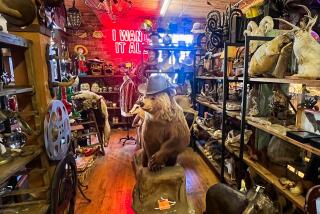Classic Hollywood: ‘Children of Giant’ explores legacy of ‘Giant’ in Marfa, Texas
Hollywood invaded the small West Texas town of Marfa 60 years ago this summer to make the epic “Giant,” based on Edna Ferber’s bestseller chronicling 25 years in the lives of a powerful rancher, his strong-willed, opinionated wife and a surly ranch hand turned oil tycoon.
The lavish Warner Bros. production was directed by Oscar winner George Stevens (“A Place in the Sun”) and starred Rock Hudson and Elizabeth Taylor as Bick and Leslie Benedict and James Dean, who would die just a few months later in a fatal car crash, as the rebellious Jett Rink.
Released in fall 1956, “Giant” was a box office hit and received 10 Academy Award nominations, winning best director for Stevens.
------------
FOR THE RECORD:
“Giant” photo: The credit for a 1955 photograph of actor James Dean with local children in Marfa, Texas, that appeared April 12 with a Classic Hollywood column about the making of the film “Giant” was incorrectly credited to only PBS. It also should have said that the photograph was from Richard C. Miller.
------------
“Giant” also was ahead of its time — a major Hollywood production that presented a feminist protagonist in Leslie and dared to shine a spotlight on the racial prejudice and segregation against Latinos in West Texas towns like Marfa.
“Children of Giant,” a documentary that kicks off a new season of the PBS Voces series on April 17, returns to Marfa — now a thriving arts community — to explore the making of the film and its legacy.
Written and directed by Hector Galan, “Children of Giant” features interviews with the director’s son, George Stevens Jr., an award-winning filmmaker himself; cast members Earl Holliman and Elsa Cárdenas; and several of residents who remember the summer when Hollywood came to town.
Galan noted that with immigration center stage in the national political debate, “Giant” seems particularly relevant today.
The filmmaker said he became interested in doing a documentary on “Giant” while doing research on the Blackwell School in Marfa, where children of Mexican descent attended classes before desegregation and where students were forced to speak English. In fact, Spanish words were put on paper and buried in a mock funeral on campus.
“My dad had to go to a segregated Mexican school in West Texas in San Angelo,” said Galan. “All of the towns — big towns, little towns — in the Southwest had segregated Mexican schools. That is what drew me to this story. I started to see the parallels of what George Stevens was doing — trying to tell a story of segregation. It struck me that it was way ahead of its times. “
Marfa may have been segregated, but the set of the movie wasn’t. “Everyone intermingled,” said Galan.
“Every day, [townspeople] could come,” Stevens noted, adding that his father “thought it would create good will in the town, and also, each person who came would be a messenger about the movie.”
Mexican actress Cárdenas, who played the Benedicts’ Latino daughter-in-law, Juana, was a teenager when cast in the high-profile role. Though she had a “wonderful experience” working on “Giant,” Cárdenas was shocked when she arrived in Marfa. In the documentary, she recalled that her white chaperone was asked how she could stand sharing a room with a Mexican girl.
“I never felt this discrimination, I thought they were just scenes in the picture,” she said via email. “When I learned it was the real thing, I was shocked, surprised and later sad and angry.”
“Giant” features several powerful sequences that deal with the racial inequality, including Bick getting into a fight when a restaurant owner tries to kick a Latino family out of the eatery as well as the marked contrast between the joyous reception the Benedicts’ son-in-law Bob (Holliman) receives at the train station when he returns home from World War II and that of Angel Obregón II (Sal Mineo).
A band and a cheering crowd welcome Bob, said Stevens, and “then you see the little newspaper clipping that Angel Obregón is coming home today. You are waiting to see him and the train pulls out and you see that flag-draped coffin with the American flag.”
In the book, said Galan, Angel didn’t die, but director Stevens changed it to make the message “much more powerful, because it did show the sacrifice of these people who were even segregated in death by being buried separately.” (A barbed wire fence still separates the white and Latino cemeteries in Marfa.)
Ramon Renteria, a columnist with the El Paso Times, was 7 when he was an extra in “Giant.”
“I grew up in a little town called Valentine, a small ranching town 35 miles west of Marfa,” said Renteria. “They erected the facade of a Mexican village right behind the Catholic cemetery, or what we knew in Valentine as the Mexican cemetery. They put out a flier that they were looking for young boys, preferably who had dogs. A few of us responded to the call. It was an exciting summer to be alive.”
Renteria and a few other boys were positioned in certain locations around the set during a scene where Taylor and Dean arrive in a jeep at the Obregón home.
“They told some of us to remove our shirts,” said Renteria. “Later on, I would write a column saying I guess they wanted us to look more Mexican. If I had known acting was that easy, I would have possibly been an actor instead of a journalist.”
“Voces: Children of Giant” premieres at 10 p.m. April 17 on KOCE.
Follow Classic Hollywood on Facebook
More to Read
Only good movies
Get the Indie Focus newsletter, Mark Olsen's weekly guide to the world of cinema.
You may occasionally receive promotional content from the Los Angeles Times.







